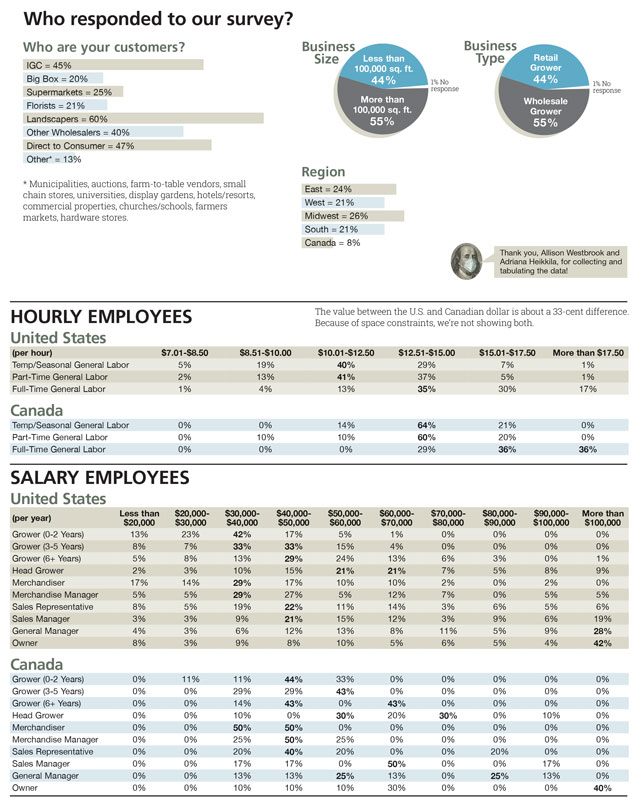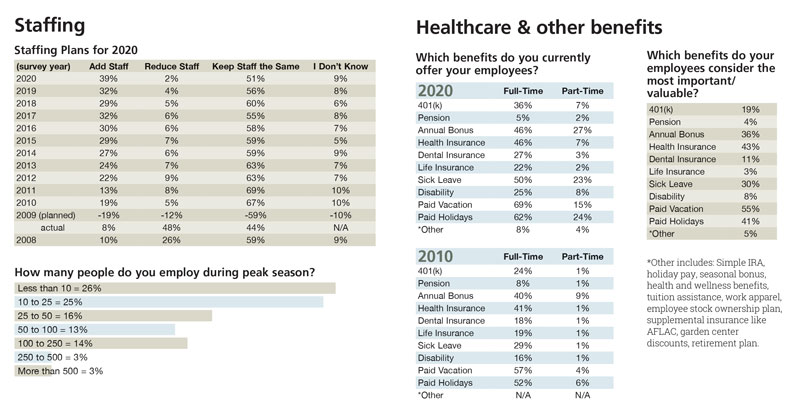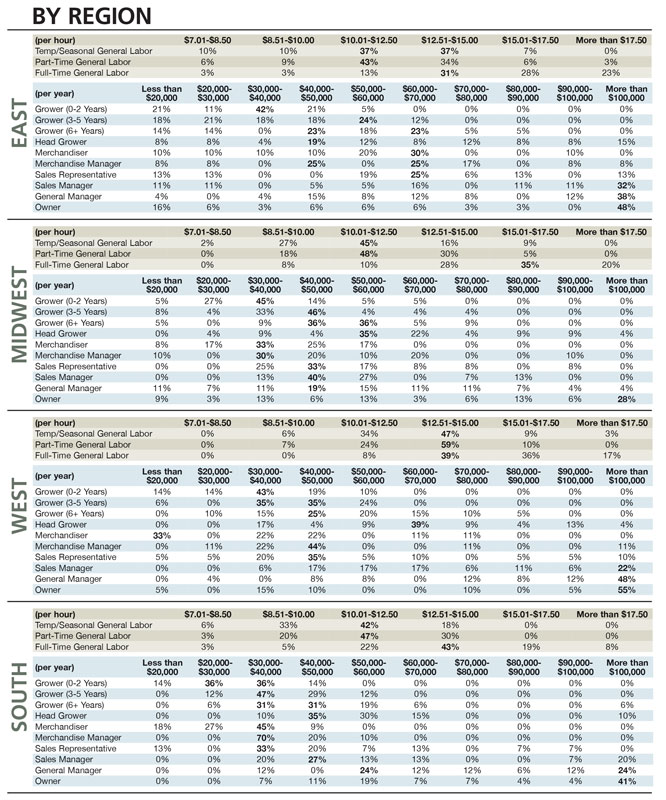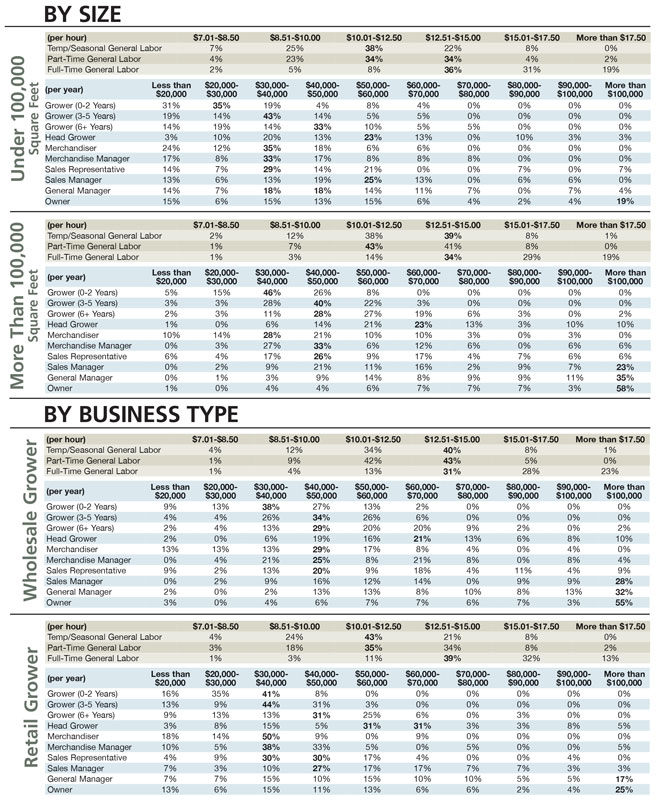12/1/2020
The COVID Monkey Wrench
Jennifer Zurko
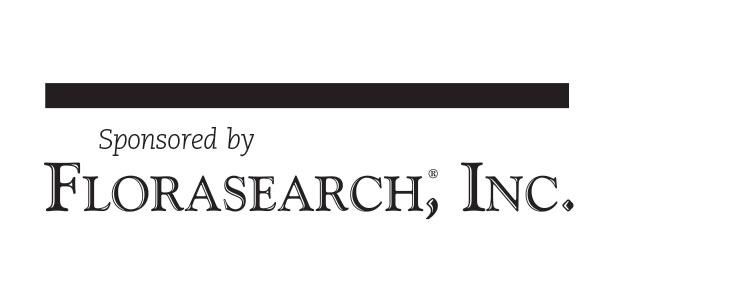
You’re still having a labor problem—it just looks a little different.
In a strange, stressful, scary year, the labor shortage issue was never more noticeable or felt more keenly. You can barely find enough people to work during peak as it is—then add in having to figure out how to meet double the demand during a pandemic. You and your staff worked extra-long hours, and after the dust settled, you were happy with the results, but glad it was over.
Now, as growers are gearing up for production season, their minds aren’t just on making sure they have enough people to handle everything, but also on keeping them safe as COVID-19 continues to be a primary part of our lives.
Since 2008, this year has the highest percentage of those surveyed saying they plan on adding staff next year (39%) and a bit less are keeping staff the same (51%). Not too many are paring down (only 2%). You could speculate that this means growers are anticipating another amazing spring. However, it’s possible this also reflects some operations who’ve split their staff into multiple shifts with a need to spread out tasks to more people over a longer period of time. (See some of your peers’ comments to the essay question below.)
We humans are a resilient bunch, and you growers and retailers have met this challenging year with aplomb and acceptance, mixed in with a bit of humor. As we look toward 2021, we asked this year’s Wage & Benefit Survey participants their plans for staffing and training around COVID-19 protocols. They’re all sensible and business-focused, as you would expect from all of the tough and motivated professionals we have in our industry.
In light of COVID-19, how do you plan on adjusting your staffing? And how will your training program change?
“Keep the same number, but separate, work stations. We’ve added more cleaning protocols and help customers at a distance. We’ve shortened hours to only be open to the public eight to nine hours a day and now train for curbside pickup and online orders.”
“Will add one to two seasonal general labor positions due to increased demand.”
“We moved our cash registers outside to reduce congestion in the store. Employees and customers are required to wear masks. Cashiers also wear Nitrile gloves when handling cash.”
“Staffing will be similar. We will adjust our offseason education classes to remote and digital conferences.”
“We continue with our online store. We do online appointments for pickups on pick-up days. Our stall is at a safe distance from incoming people, which are other commercial growers and I (owner) am the only one in contact. Every human hears and knows about what symptoms are and what to do; no training required.”
“Our employees have worked for us from five to 25 years. We are a small family business and all employees are trained to multi-task and know every aspect of growing plants, from cutting stage to finished product. All are well-paid—lowest wage is $15 up to $21. Happy employees makes happy production numbers.”
“In response to COVID-19, we moved all nursery workers to independent rather than team-based work.”
“Due to the expectation of continued social distancing, we plan to increase the length of our workdays to be able to stay on track with planting.”
“We have and will continue to modify our safety plan as we move through the pandemic and with our seasons. Our staff will increase next year and we will be upping our training on sanitation, cleaning and personal health actions.”
“Changing to shift work with less people per shift; add more work space for production.”
“We plan to increase our staff levels, but will mostly stay the course, as most of the changes that we implemented in 2020 were adequate.”
“Staggered shifts, job sharing for part-time workers to minimize staff on site; lots of COVID education. Proper use of PPE and correct cleaning/disinfecting methods will be ongoing at staff huddles. Documentation of all of the above in employee files.”
“We do not plan to reduce our staff in 2021; we may add a few employees. We now have some office staff working remotely and are spread out more in the office due to COVID-19. We have a mask policy for all of our employees, and even in the warmer months, our team did a great job adhering to wearing a mask while at work.”
“Our sales are growing, so we will add staff. We spent money on Plexiglass panels, motorized conveyors and added more people than normal. Worked 6-ft. apart and provided masks.”
“No change in plans on staffing outside of an additional cleaning crew we would have on-site. But with business up due to COVID, we are expanding our staff due to the business growth. From a training standpoint, we have implemented new protocols in how we do work and how we clean the facility, and we have done training and then signage reminders throughout the facility to make it more apparent.”
“Safety training has always been a priority—COVID-19 added another layer to our safety training.”
“We had to adjust our assembly line processes in transplant and shipping to meet CDC distancing guidelines. We plan to keep the same amount of staffing, but have looked into longer days with alternating staff days to avoid burnout. Training will remain the same with basis on social distancing emphasized.”
“Retain greater numbers of people in non-peak times so less people are needed in peak times.”
“We have adjusted hours—start times, break times and lunches in order to ensure social distancing. It is mandatory for employees to wear face masks while inside and when coming in contact with outside persons, for instance shipping. I only hire one person per department, per week, to ensure smaller training.”
“We will need huge adjustment if we can’t bring in foreign workers. COVID training on masks, social distancing and working/living together.”
“We will continue to abide by the CDC protocols for social distancing and wearing masks. Breaks and lunches will continue to be staggered with a cleaning protocol in place after each break and lunch period. We will limit how many ‘new’ employees will be onboarded on any given day.”
“Our business fell under ‘essential’ when COVID was shutting down others—since then we’ve had near-record business—we are looking for help! Regarding training, we meet with the crew in small groups regularly to reiterate the ever-changing CDC guidelines.”
“We have been doing more with fewer people due to the virus. We did not get H-2A workers and won’t next spring either, as our housing is not amenable to social distancing.”
“Staffing will mostly remain the same. We are making some workplace modifications—both physical in production areas and schedule-wise for cohorting. We have been stockpiling PPE to get through the busy spring production season. Training remains the same, other than information about distancing, break areas and mask requirements.”
“We plan to change our onboarding. We will cross train our grower-ready team with our retail-ready team. Our training for SOPs will be classroom-style following the CDC social distancing guidelines.”
Three Suggestions
By Bob Zahra
1) For the career, horticulture industry employee: Prior to changing positions for a new opportunity, it’s rare for a career industry employee to secure every advantage sought. In fact, if someone waits for the absolute perfect position, with every box checked, he or she never may change positions. This is something like the old adage: “If you wait until you have enough money to afford children, you never will have children.”
There’s a certain amount of career risk in every position accepted (including remaining static in a current position) and the taking of a measured amount of career risk is what propels careers. No risk, no career advancement.
2) For the hiring authority: If your company is attempting to fill an important position, and the position description is so broad that it accommodates either: an experienced industry person; someone from outside of the industry; or a recent industry graduate, it’s time to tighten the position description because the target candidate for this search is too broad.
A recent graduate shouldn’t be capable of performing the same function as a proven industry professional. In time, yes, but it takes time to become proven. The out-of-industry individual at the very least should have a background rich in perishability and seasonality. If each of these three candidates is acceptable at search inception, then the optimum candidate hasn’t been adequately defined.
Instead of taking an overly broad, shotgun approach to identifying and recruiting the important employee your company requires, consider limiting your candidate search target to those who are optimal for the open position—a rifle shot approach. Flexibility during the search process is fine, but before the search is initiated, it’s preferable to have a clear fix on the target.
3) For the hiring authority: Senior level, proven candidates are reflexively treated with deference by a company attempting to fill an executive level position. This level of respect isn’t always accorded the mid-level candidate, although the mid-level candidate grows into the future executive and has many more years of exposure to the hiring authority, whether as a team member or a competitor.
Please consider not only the current value, but the future value of the mid-level employee as well. Going out of your way on behalf of your company to establish a positive first impression with a promising mid-level candidate can pay dividends for an entire career, even if the candidate isn’t hired by your company.
Bob Zahra is an executive search consultant with Florasearch, Inc., a certified personnel consultant, and past chair of the National Association of Executive Recruiters. He can be reached at (407) 320-8177 or bzahra@florasearch.com. Visit www.florasearch.com.
